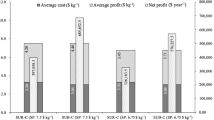Abstract
Salmon farming in Chile constitutes one of the nation's principal food exporting sectors. In the seawater stage, one of the most important in the farm production chain, salmon are cultivated in floating cages fitted with nets that hold the fish during the entire grow-out process. The maintenance of the cage nets is carried out at land-based facilities. This article reports on the creation of an integer programming tool for grow-out centres that optimizes resource use, improves planning and generates economic evaluations for supporting analysis and decision-making relating to the maintenance, repair and periodic changing of cage nets. The tool prototype was tested in a single operating area of one of Chile's largest salmon farmers. The results demonstrated a reduction in net maintenance costs of almost 18%, plus a series of important qualitative benefits. Implementation of the tool by farm operators awaits the end of the current crisis in the industry.




Similar content being viewed by others
References
Asheim LJ, Lien GD, Richardson JW, Tveteras R and Veggeland F (2005). Modelling risks in the salmon industry and markets. In: 95th Seminar, 9-10 December 2005, Civitavecchia, Italy, European Association of Agricultural Economists: The Hague, Netherlands.
Bjørndal T, Lane DE and Weintraub A (2004). Operational research models and the management of fisheries and aquaculture: A review. European Journal of Operational Research 156 (3): 533–540.
Brown W and Hussen A (1974). A production economic analysis of the little white salmon and Willard National Fish Hatcheries. Technical Report 428, Oregon State University, Agricultural experiment station.
Cabrera V, Fraisse C, Letson D, Podesta G and Novak J (2006). Impact of climate information on reducing farm risk by optimizing crop insurance strategy. Transactions of the ASABE 49 (4): 1223–1233.
Crampton V, Bergheim A, Gausen M, Naess A and Holland P (2003). Effects of low oxygen on fish performance, oxygen levels in commercial salmon farming conditions. EWOS Perspective, UK Edition 2: 8–13.
Färe R, Grosskopf S, Roland BE and Weber WL (2009). License fees: The case of Norwegian salmon farming. Aquaculture Economics Management 13 (1): 1–21.
Forsberg OI (1996). Optimal stocking and harvesting of size-structured farmed fish: A multi-period linear programming approach. Mathematics and Computers in Simulation 42 (2–3): 299–305.
Forsberg OI (1999). Optimal harvesting of farmed Atlantic salmon at two cohort management strategies and different harvest operation restrictions. Aquaculture Economics & Management 3 (2): 143–158.
Forsberg OI and Guttormsen AG (2006). Modeling optimal dietary pigmentation strategies in farmed Atlantic salmon: Application of mixed-integer non-linear mathematical programming techniques. Aquaculture 261 (1): 118–124.
Godoy M et al (2007). Primera detección, aislamiento y caracterización molecular de isa-v en salmón del atlántico (salmo salar) de cultivo en chile (in Spanish). SalmoCiencia on-line 3: 47–55.
Gustavson M (1972). Maximizing profits for a commercial salmon rearing facility using linear programming. Master's Thesis, Naval Posgraduate School, Monterrey, CA.
Hilborn R (1989). Salmon production, management, and allocation. Transactions of the American Fisheries Society 118 (1): 90–93.
Hilborn R and Walters C (1992). Quantitative fisheries stock assessment: Choice, dynamics and uncertainty. Reviews in Fish Biology and Fisheries 2 (2): 177–178.
Jensson P and Gunn E (2001). Optimization of production planning in fish farming. Technical report, University of Iceland.
Letson D, Podesta G, Messina C and Ferreyra R (2005). The uncertain value of perfect ENSO phase forecasts: Stochastic agricultural prices and intra-phase climatic variations. Climatic Change 69 (2–3): 163–196.
Leung P (2005). Multiple-criteria decision-making (mcdm) applications in fishery management. International Journal of Environmental Technology and Management 6 (1–2): 96–110.
Liu Y and Sumaila UR (2010). Estimating pollution abatement costs of salmon aquaculture: A joint production approach. Land Economics 86 (3): 569–584.
Pomeroy R, Bravo-Ureta B, Solis D and Johnston R (2008). Bioeconomic modelling and salmon aquaculture: An overview of the literature. International Journal of Environment and Pollution 33 (4): 485–500.
Rothschild B (1986). Dynamics of Marine Fish Populations. Harvard University Press: Cambridge, MA.
Rye M and Mao I (1998). Nonadditive genetic effects and inbreeding depression for body weight in Atlantic salmon (Salmo salar L). Livestock Production Science 57 (1): 15–22.
Stien LH, Kiessling A and Manne F (2007). Rapid estimation of fat content in salmon fillets by colour image analysis. Journal of Food Composition and Analysis 20 (2): 73–79.
Weintraub A, Romero C, Bjørndal T and Epstein R (2010). Handbook of Operations Research in Natural Resources. International Series in Operations Research and Management Science Series Springer: Berlin.
Yu R and Leung P (2006). Optimal partial harvesting schedule for aquaculture operations. Marine Resource Economics 21 (3): 301–331.
Acknowledgements
The authors are grateful to CORFO (Chilean government program), Salmones Multiexport S.A. and the Chilean Science Institute ‘Complex Engineering Systems’ (ICM: P-05-004-F; CONICYT: FBO16; www.isci.cl) for their financial support in carrying out this project. Thanks are also due to Fredi Espinoza for his contribution to the analysis of the proposed tool's impact, Juan Pablo Zanlungo for his efforts in gathering statistics on the Chilean salmon farming industry, Javier Marenco for his support at various stages of the study, Kenneth Rivkin for his many useful suggestions, and Rodrigo Niklitschek of Salmones Multiexport for his collaboration in bringing this project to fruition. The third author was partly financed by Fondecyt grant 1110797 (Chile), ANPCyT PICT-2007-00518 (Argentina), and UBACyT grant 20020100100980 (Argentina), and the fifth author was partly financed by Fondecyt grant 1100265 (Chile).
Author information
Authors and Affiliations
Corresponding author
Rights and permissions
About this article
Cite this article
Cisternas, F., Donne, D., Durán, G. et al. Optimizing salmon farm cage net management using integer programming. J Oper Res Soc 64, 735–747 (2013). https://doi.org/10.1057/jors.2012.74
Received:
Accepted:
Published:
Issue Date:
DOI: https://doi.org/10.1057/jors.2012.74




